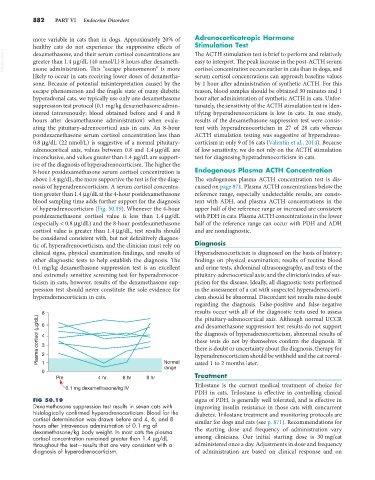Page 910 - Small Animal Internal Medicine, 6th Edition
P. 910
882 PART VI Endocrine Disorders
more variable in cats than in dogs. Approximately 20% of Adrenocorticotropic Hormone
healthy cats do not experience the suppressive effects of Stimulation Test
VetBooks.ir dexamethasone, and their serum cortisol concentrations are The ACTH stimulation test is brief to perform and relatively
easy to interpret. The peak increase in the post-ACTH serum
greater than 1.4 µg/dL (40 nmol/L) 8 hours after dexameth-
asone administration. This “escape phenomenon” is more
serum cortisol concentrations can approach baseline values
likely to occur in cats receiving lower doses of dexametha- cortisol concentration occurs earlier in cats than in dogs, and
sone. Because of potential misinterpretation caused by the by 1 hour after administration of synthetic ACTH. For this
escape phenomenon and the fragile state of many diabetic reason, blood samples should be obtained 30 minutes and 1
hyperadrenal cats, we typically use only one dexamethasone hour after administration of synthetic ACTH in cats. Unfor-
suppression test protocol (0.1 mg/kg dexamethasone admin- tunately, the sensitivity of the ACTH stimulation test in iden-
istered intravenously; blood obtained before and 4 and 8 tifying hyperadrenocorticism is low in cats. In one study,
hours after dexamethasone administration) when evalu- results of the dexamethasone suppression test were consis-
ating the pituitary-adrenocortical axis in cats. An 8-hour tent with hyperadrenocorticism in 27 of 28 cats whereas
postdexamethasone serum cortisol concentration less than ACTH stimulation testing was suggestive of hyperadreno-
0.8 µg/dL (22 nmol/L) is suggestive of a normal pituitary- corticism in only 9 of 16 cats (Valentin et al., 2014). Because
adrenocortical axis, values between 0.8 and 1.4 µg/dL are of low sensitivity, we do not rely on the ACTH stimulation
inconclusive, and values greater than 1.4 µg/dL are support- test for diagnosing hyperadrenocorticism in cats.
ive of the diagnosis of hyperadrenocorticism. The higher the
8-hour postdexamethasone serum cortisol concentration is Endogenous Plasma ACTH Concentration
above 1.4 µg/dL, the more supportive the test is for the diag- The endogenous plasma ACTH concentration test is dis-
nosis of hyperadrenocorticism. A serum cortisol concentra- cussed on page 871. Plasma ACTH concentrations below the
tion greater than 1.4 µg/dL at the 4-hour postdexamethasone reference range, especially undetectable results, are consis-
blood sampling time adds further support for the diagnosis tent with ADH, and plasma ACTH concentrations in the
of hyperadrenocorticism (Fig. 50.19). Whenever the 4-hour upper half of the reference range or increased are consistent
postdexamethasone cortisol value is less than 1.4 µg/dL with PDH in cats. Plasma ACTH concentrations in the lower
(especially < 0.8 µg/dL) and the 8-hour postdexamethasone half of the reference range can occur with PDH and ADH
cortisol value is greater than 1.4 µg/dL, test results should and are nondiagnostic.
be considered consistent with, but not definitively diagnos-
tic of, hyperadrenocorticism, and the clinician must rely on Diagnosis
clinical signs, physical examination findings, and results of Hyperadrenocorticism is diagnosed on the basis of history;
other diagnostic tests to help establish the diagnosis. The findings on physical examination; results of routine blood
0.1 mg/kg dexamethasone suppression test is an excellent and urine tests, abdominal ultrasonography, and tests of the
and extremely sensitive screening test for hyperadrenocor- pituitary-adrenocortical axis; and the clinician’s index of sus-
ticism in cats, however, results of the dexamethasone sup- picion for the disease. Ideally, all diagnostic tests performed
pression test should never constitute the sole evidence for in the assessment of a cat with suspected hyperadrenocorti-
hyperadrenocorticism in cats. cism should be abnormal. Discordant test results raise doubt
regarding the diagnosis. False-positive and false-negative
8 results occur with all of the diagnostic tests used to assess
Plasma cortisol (µg/dL) 4 the diagnosis of hyperadrenocorticism, abnormal results of
the pituitary-adrenocortical axis. Although normal UCCR
and dexamethasone suppression test results do not support
6
these tests do not by themselves confirm the diagnosis. If
3
there is doubt or uncertainty about the diagnosis, therapy for
2
Normal
uated 1 to 2 months later.
1
range hyperadrenocorticism should be withheld and the cat reeval-
0
Pre 4 hr 6 hr 8 hr Treatment
Trilostane is the current medical treatment of choice for
0.1 mg dexamethasone/kg IV
PDH in cats. Trilostane is effective in controlling clinical
FIG 50.19 signs of PDH, is generally well tolerated, and is effective in
Dexamethasone suppression test results in seven cats with improving insulin resistance in those cats with concurrent
histologically confirmed hyperadrenocorticism. Blood for the diabetes. Trilostane treatment and monitoring protocols are
cortisol determination was drawn before and 4, 6, and 8 similar for dogs and cats (see p. 871). Recommendations for
hours after intravenous administration of 0.1 mg of
dexamethasone/kg body weight. In most cats the plasma the starting dose and frequency of administration vary
cortisol concentration remained greater than 1.4 µg/dL among clinicians. Our initial starting dose is 30 mg/cat
throughout the test—results that are very consistent with a administered once a day. Adjustments in dose and frequency
diagnosis of hyperadrenocorticism. of administration are based on clinical response and on

